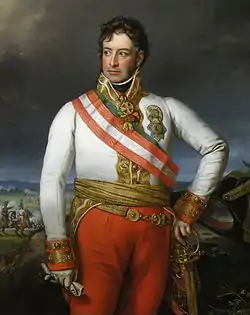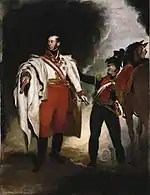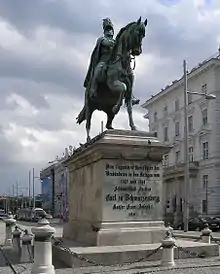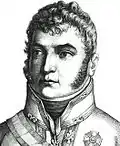Karl Philipp, Prince of Schwarzenberg
Karl Philipp, Fürst zu Schwarzenberg (or Charles Philip, Prince of Schwarzenberg; 18/19 April 1771 – 15 October 1820) was an Austrian field marshal.[1]
Prince of Schwarzenberg | |
|---|---|
 Portrait of the prince of Schwarzenberg | |
| Birth name | Karl Philipp |
| Born | 18 April 1771 Vienna, Habsburg Monarchy |
| Died | 15 October 1820 (aged 49) Leipzig, Kingdom of Saxony |
| Allegiance | |
| Years of service | 1789–1820 |
| Rank | Generalfeldmarschall |
| Battles/wars | French Revolutionary Wars
|
| Awards | Order of the Golden Fleece Military Order of Maria Theresa Military Order of Max Joseph Legion of Honour Order of the Holy Spirit Order of the Bath Military William Order |
| Relations | Johann Nepomuk Anton of Schwarzenberg (father) Marie Eleonore Countess of Öttingen-Wallerstein (mother) |
Family
Karl Philipp was born 18/19 April 1771 in Vienna,[2] the son of Johann Nepomuk Anton of Schwarzenberg and Marie Eleonore Countess of Öttingen-Wallerstein. He was one of thirteen siblings, seven of whom did not reach adulthood.[3]
Imperial service

Karl Philipp entered the imperial cavalry in 1788, fought in 1789 under Lacy and Loudon against the Turks, distinguished himself by his bravery, and became a major in 1792.[2] In the French campaign of 1793 he served in the advanced guard of the army commanded by Prince Josias of Coburg, and at Le Cateau-Cambrésis in 1794 his impetuous charge at the head of his regiment, vigorously supported by twelve British squadrons, broke a whole corps of the French, killed and wounded 3,000 men, and captured 32 of the enemy's guns. He was immediately decorated with the Knight's Cross of the Military Order of Maria Theresa.[4]
After taking part in the battles of Amberg and Würzburg in 1796 during the French Revolutionary Wars, he was raised to the rank of general-major, and, in 1799, he subsequently was promoted to Feldmarschall-Leutnant. At the Battle of Hohenlinden (3 December 1800) he led a division in the right wing.[5] During the retreat, his promptitude and courage saved the right wing of the Austrian army from destruction, and the Archduke Charles of Austria afterwards entrusted him with the command of the rearguard.[4] In 1804 Prince Karl Philipp was created Fürst zu Schwarzenberg in a title identical to, but separate from, that of his brother, Joseph, Prince of Schwarzenberg.[3]
In the war of 1805 he held command of a division under Mack, and when Napoleon surrounded Ulm in October, Schwarzenberg was one of the band of cavalry, under the Archduke Ferdinand of Austria-Este, which cut its way through the hostile lines. In the same year he received the Commander's Cross of the Order of Maria Theresa and in 1809 he was awarded the Order of the Golden Fleece.[4]
In 1806–1809 Schwarzenberg served as the Austrian ambassador to Russia.[2] He returned to Austria in time to take part in the Battle of Wagram (July 1809), leading a cavalry division in the Reserve Corps[6] and was soon afterwards promoted to general of cavalry. After the signing of Treaty of Schönbrunn (14 October 1809), he was sent to Paris to negotiate the 1810 marriage between Napoleon and the Archduchess Marie Louise of Austria.[4] The prince gave a ball in honour of the bride on 1 July 1810, which ended in a fire that killed many of the guests, including his own sister-in-law, wife of his older brother, Joseph.[7]
Napoleon held Schwarzenberg in great esteem, and at his request the prince took command of the Austrian auxiliary corps in the Russian campaign of 1812. The Austrian general won some minor victories against the Russians at Gorodetschna and Wolkowisk. Afterwards, under instructions from Napoleon, he remained for some months inactive at Pultusk.[8]
In 1813, when Austria, after many hesitations, took the side of the allies against Napoleon, Schwarzenberg, recently promoted to Feldmarschall, was appointed commander-in-chief of the allied Grand Army of Bohemia. As such, he was the senior of the allied generals who conducted the campaign of 1813–1814.[9] Under his command, the allied army was mauled by Napoleon at the Battle of Dresden on 26–27 August and driven back into Bohemia. However, his army defeated pursuing French forces at the Second Battle of Kulm (17 September 1813). Returning to the fray, he led the Allied army north again and played a major role in Napoleon's decisive defeat at the Battle of Leipzig on 16–18 October. During the invasion of France in 1814 he attacked through Switzerland and beat a French force at the Battle of Bar-sur-Aube on 27 February 1814. He repelled an attack by Napoleon in the Battle of Arcis-sur-Aube on 20–21 March and overcame the last barrier before Paris by winning the Battle of Fère-Champenoise on 25 March. His capture of the French capital on 31 March after the Battle of Paris resulted in the overthrow of Napoleon.[10]
The next year, during the Hundred Days when Napoleon escaped from Elba and regained the French throne, in the hostilities that followed Schwarzenberg commanded the Army of the Upper Rhine (an Austrian-allied army of about a quarter of a million men).[11] But shortly afterwards, having lost his sister Caroline, to whom he was deeply attached, he fell ill. A stroke disabled him in 1817, and in 1820, when revisiting Leipzig, the scene of the "Battle of the Nations" that he had directed seven years before, he suffered a second stroke. He died there on 15 October.[9]
Marriage and descendants
The Prince married the Countess Maria Anna von Hohenfeld (20 May 1767–1848), who was the widow of Prince Anton Esterhazy. They had three sons:[3]
- Friedrich, Prince of Schwarzenberg (1800–70), his eldest son, had an adventurous career as a soldier, and described his wanderings and campaigns in several interesting works, of which the best known is his Wanderungen eines Lanzknechtes (1844–1845). He took part as an Austrian officer in the campaigns of Galicia 1846, Italy 1848 and Hungary 1848, and as an amateur in the French conquest of Algeria, the Carlist Wars in Spain and the Swiss civil war of the Sonderbund. He became a major-general in the Austrian army in 1849, and died after many years of well-filled leisure in 1870.
- Karl II Borromäus Philipp (1802–1858), the second son, was a Feldzeugmeister;
- Edmund Leopold Friedrich (1803–73), his third son, was a field marshal in the Austrian army.
Of Schwarzenberg's nephews, Felix Schwarzenberg, the statesman, was also notable, and Friedrich Johann Josef Coelestin (1809–1885) was a cardinal and a prominent figure in papal and Austrian history.[9]
Honours
 Habsburg Monarchy:
Habsburg Monarchy:
- Knight of the Military Order of Maria Theresa, 25 May 1794;[12] Commander, 1806;[13] Grand Cross, 1813[14]
- Knight of the Golden Fleece, 1809[14]
- Grand Cross of St. Stephen, 1810[15]
- France:
.svg.png.webp) French Empire: Grand Eagle of the Legion of Honour, 1811[16]
French Empire: Grand Eagle of the Legion of Honour, 1811[16] Kingdom of France: Knight of the Holy Spirit, 1816[17]
Kingdom of France: Knight of the Holy Spirit, 1816[17]
 Russian Empire:
Russian Empire:
- Knight of St. George, 1st Class, 8 October 1813[18]
- Knight of St. Andrew, 11 October 1813[18]
- Knight of St. Alexander Nevsky, 11 October 1813[18]
 Sweden: Grand Cross of the Sword, 1st Class, 20 February 1814[19]
Sweden: Grand Cross of the Sword, 1st Class, 20 February 1814[19].svg.png.webp) Kingdom of Bavaria:
Kingdom of Bavaria:
- Knight of St. Hubert, 1814[20]
- Grand Cross of the Military Order of Max Joseph, 1815[21]
.svg.png.webp) Kingdom of Sardinia: Knight of the Annunciation, 4 January 1815[22]
Kingdom of Sardinia: Knight of the Annunciation, 4 January 1815[22] Denmark: Knight of the Elephant, 30 April 1815[23]
Denmark: Knight of the Elephant, 30 April 1815[23] United Kingdom: Honorary Grand Cross of the Bath (military), 18 August 1815[24]
United Kingdom: Honorary Grand Cross of the Bath (military), 18 August 1815[24] Netherlands: Grand Cross of the Military William Order, 27 August 1815[25]
Netherlands: Grand Cross of the Military William Order, 27 August 1815[25] Kingdom of Hanover: Grand Cross of the Royal Guelphic Order, 1816[26]
Kingdom of Hanover: Grand Cross of the Royal Guelphic Order, 1816[26]
Gallery
 Coat of arms of the Schwarzenberg princes
Coat of arms of the Schwarzenberg princes
 Engraving from "Zweihundert deutsche Männer in Bildnissen und Lebensbeschreibungen", by Ludwig Bechstein, 1854
Engraving from "Zweihundert deutsche Männer in Bildnissen und Lebensbeschreibungen", by Ludwig Bechstein, 1854
Ancestry
| Ancestors of Karl Philipp, Prince of Schwarzenberg | ||||||||||||||||||||||||||||||||||||||||||||||||||||||||||||||||||||||||||||||||||||||||||||||||||||||||||||||||||||||||||||||||||||||||||||||||||||||||||||||||||||||||||||||||||||||||||||||||||||||||||||||||||||||||||||||||||||||||||||||||||||||||||||||||||||||||||||||||||||||||||||||||||||||||||||||||||||||||||||||||||||||||||||||||||||||||||||||||||||||||||||||||||||||||||||||||||||||||||||||||||||||||||||||||||||||||||||||||||||||||||||||||||||||||||||||||||||||||||||||||||||||||||||||||||||||||||||||||||||||||||||||||||||||||||||||||||||||||||||||||||||||||||||||||||||||||||||||||
|---|---|---|---|---|---|---|---|---|---|---|---|---|---|---|---|---|---|---|---|---|---|---|---|---|---|---|---|---|---|---|---|---|---|---|---|---|---|---|---|---|---|---|---|---|---|---|---|---|---|---|---|---|---|---|---|---|---|---|---|---|---|---|---|---|---|---|---|---|---|---|---|---|---|---|---|---|---|---|---|---|---|---|---|---|---|---|---|---|---|---|---|---|---|---|---|---|---|---|---|---|---|---|---|---|---|---|---|---|---|---|---|---|---|---|---|---|---|---|---|---|---|---|---|---|---|---|---|---|---|---|---|---|---|---|---|---|---|---|---|---|---|---|---|---|---|---|---|---|---|---|---|---|---|---|---|---|---|---|---|---|---|---|---|---|---|---|---|---|---|---|---|---|---|---|---|---|---|---|---|---|---|---|---|---|---|---|---|---|---|---|---|---|---|---|---|---|---|---|---|---|---|---|---|---|---|---|---|---|---|---|---|---|---|---|---|---|---|---|---|---|---|---|---|---|---|---|---|---|---|---|---|---|---|---|---|---|---|---|---|---|---|---|---|---|---|---|---|---|---|---|---|---|---|---|---|---|---|---|---|---|---|---|---|---|---|---|---|---|---|---|---|---|---|---|---|---|---|---|---|---|---|---|---|---|---|---|---|---|---|---|---|---|---|---|---|---|---|---|---|---|---|---|---|---|---|---|---|---|---|---|---|---|---|---|---|---|---|---|---|---|---|---|---|---|---|---|---|---|---|---|---|---|---|---|---|---|---|---|---|---|---|---|---|---|---|---|---|---|---|---|---|---|---|---|---|---|---|---|---|---|---|---|---|---|---|---|---|---|---|---|---|---|---|---|---|---|---|---|---|---|---|---|---|---|---|---|---|---|---|---|---|---|---|---|---|---|---|---|---|---|---|---|---|---|---|---|---|---|---|---|---|---|---|---|---|---|---|---|---|---|---|---|---|---|---|---|---|---|---|---|---|---|---|---|---|---|---|---|---|---|---|---|---|---|---|---|---|---|---|---|---|---|---|---|---|---|---|---|---|---|---|---|---|---|---|---|---|---|---|---|---|---|---|---|---|---|---|---|---|---|---|---|---|---|---|---|---|---|---|---|---|---|---|---|---|---|---|---|---|---|---|---|---|---|---|---|---|---|---|---|---|---|---|---|---|---|---|---|---|---|---|---|---|---|---|---|---|---|---|---|---|---|---|---|---|---|---|---|---|---|---|---|---|---|---|---|---|---|---|---|---|---|---|---|---|---|---|---|---|---|---|---|---|---|---|---|---|---|---|---|---|---|---|---|---|---|---|---|---|---|---|---|---|---|---|---|---|---|---|---|---|---|
| ||||||||||||||||||||||||||||||||||||||||||||||||||||||||||||||||||||||||||||||||||||||||||||||||||||||||||||||||||||||||||||||||||||||||||||||||||||||||||||||||||||||||||||||||||||||||||||||||||||||||||||||||||||||||||||||||||||||||||||||||||||||||||||||||||||||||||||||||||||||||||||||||||||||||||||||||||||||||||||||||||||||||||||||||||||||||||||||||||||||||||||||||||||||||||||||||||||||||||||||||||||||||||||||||||||||||||||||||||||||||||||||||||||||||||||||||||||||||||||||||||||||||||||||||||||||||||||||||||||||||||||||||||||||||||||||||||||||||||||||||||||||||||||||||||||||||||||||||
Notes
- Regarding personal names: Fürst is a title, translated as Prince, not a first or middle name. The feminine form is Fürstin.
- Tucker 2014, p. 673.
- Biographisches Lexikon des Kaiserthums Oesterreich, Band: 33 (1877), ab Seite: 82.
- Chisholm 1911, p. 390.
- Arnold 2005, p. 249.
- Bowden & Tarbox 1980, p. 167.
- Sir Walter Scott, The Edinburgh Annual Register, John Ballantyne and Company, 1812, Volume 1; Volume 3, Part 1, pp. 333–334. The party included some 1200 guests, which was larger than the assembly room could hold, so a temporary building was formed of planks, which were hidden by gauze, muslin and other draperies. The draperies caught fire, and the whole room was enveloped. Princess Pauline Schwarzenburg, although she had initially escaped, ran back into the ball room in search of one of her daughters. Her body was only recognized by the diamonds she wore.
- Chisholm 1911, pp. 390–391.
- Chisholm 1911, p. 391.
- Digby Smith. The Napoleonic Wars Data Book. London: Greenhill, 1998. ISBN 978-1853672767 pp. 443–445, 455, 461–465, 512–514, 516–517.
- Siborne 1895, p. 767.
- "Ritter-Orden: Militärischer Maria-Theresien-Orden", Hof- und Staats-Schematismus der Röm. Kais. auch Kais. Königlich- und Erzherzoglichen Haupt-und-Residenzstadt Wien, 1798, p. 398, retrieved 10 December 2020
- "Ritter-Orden: Militärischer Maria-Theresien-Orden", Hof- und Staatshandbuch des Kaiserthumes Österreich, 1808, p. 10, retrieved 16 October 2020
- "Ritter-Orden", Hof- und Staatshandbuch des Kaiserthumes Österreich, 1819, pp. 7, 9, retrieved 16 October 2020
- "A Szent István Rend tagjai" Archived 22 December 2010 at the Wayback Machine
- Almanach impérial. Testu. 1811. p. 65.
- Teulet, Alexandre (1863). "Liste chronologique des chevaliers de l'ordre du Saint-Esprit depuis son origine jusqu'à son extinction (1578-1830)" [Chronological List of Knights of the Order of the Holy Spirit from its origin to its extinction (1578-1830)]. Annuaire-bulletin de la Société de l'histoire de France (in French) (2): 114. Retrieved 20 May 2020.
- Almanach de la cour: pour l'année ... 1817. l'Académie Imp. des Sciences. 1817. pp. 66, 86, 89.
- Court Calendar for the Year 1815, p. 141
- Bayern (1819). Hof- und Staatshandbuch des Königreichs Bayern: 1819. Landesamt. p. 9.
- Kramer, Rudolf von; Waldenfels, Otto Freiherr von (1966). VIRTUTI PRO PATRIA – Der königlich bayerische Militär-Max-Joseph-Orden Kriegstaten und Ehrenbuch 1914–1918, Selbstverlag des königlich bayerischen Militär-Max-Joseph-Ordens (in German). München. p. 443
- Luigi Cibrario (1869). Notizia storica del nobilissimo ordine supremo della santissima Annunziata. Sunto degli statuti, catalogo dei cavalieri. Eredi Botta. p. 99.
- J ..... -H ..... -Fr ..... Berlien (1846). Der Elephanten-Orden und seine Ritter. Berling. pp. 144–145.
- Shaw, Wm. A. (1906) The Knights of England, I, London, p. 183
- (in Dutch) Military William Order: Schwarzenberg, Karl Phillip Fürst zu. Retrieved 12 August 2020.
- Hannoverscher und Churfürstlich-Braunschweigisch-Lüneburgischer Staatskalender: 1819. 1819. p. 12.
References
| Wikimedia Commons has media related to Karl Philipp, Prince of Schwarzenberg. |
- Arnold, James R. (2005). Marengo & Hohenlinden. Barnsley, Yorkshire: Pen & Sword. ISBN 1-84415-279-0.
- Bowden, Scotty; Tarbox, Charlie (1980). Armies on the Danube 1809. Arlington, Texas: Empire Games Press.
- Siborne, William (1895). "Supplement section". The Waterloo Campaign 1815 (4th ed.). Birmingham, 34 Wheeleys Road. pp. 767–780.
- Tucker, Spencer C. (2014). 500 Great Military Leaders [2 volumes]. ABC-CLIO. ISBN 978-1598847581.
Attribution:
 This article incorporates text from a publication now in the public domain: Chisholm, Hugh, ed. (1911). "Schwarzenberg, Karl Philipp, Prince zu". Encyclopædia Britannica. 24 (11th ed.). Cambridge University Press. pp. 390–391. Endnotes:
This article incorporates text from a publication now in the public domain: Chisholm, Hugh, ed. (1911). "Schwarzenberg, Karl Philipp, Prince zu". Encyclopædia Britannica. 24 (11th ed.). Cambridge University Press. pp. 390–391. Endnotes:
- Anton von Prokesch-Osten: Denkwürdigkeiten aus dem Leben des Feldmarschalls Fürsten Carl zu Schwarzenberg. Vienna, 1823
- Adolph Berger: Das Fürstenhaus Schwarzenberg. Vienna, 1866
- and a memoir by Adolph Berger in Streffleur's Österreichische Militärische Zeitschrift Jhg. 1863.